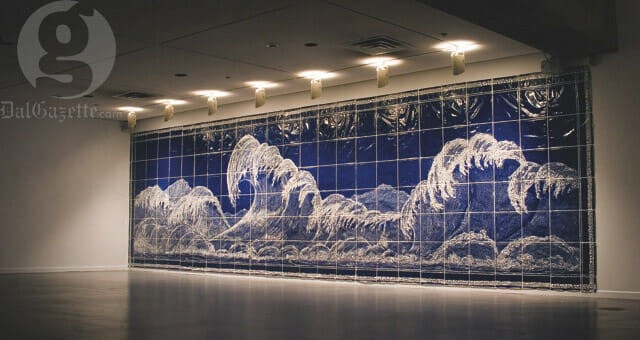
Other Worlds
Descending the stairs to the basement of the Rebecca Cohn, you glimpse a whale through glass; suddenly you’re peering into an alien ocean through a ship’s porthole window.
Descending the stairs to the basement of the Rebecca Cohn, you glimpse a whale through glass; suddenly you’re peering into an alien ocean through a ship’s porthole window. Even before you enter the Dalhousie Art Gallery for Douglas Walker’s Other Worlds exhibit, he’s already transforming your perception.
When you arrive, firmly footed inside the gallery doors, you now gaze up at the same, yet suddenly celestial, whale; a complex, amoebic moon beams in your peripheral vision. For Walker’s exhibit you have to absorb the uncanny weirdness first hand. But, stare too long, and you might have trouble distinguishing ceramic from paper, subaqueous from empyreal, microscopic from telescopic or Moby Dick from Philip K. Dick .
Douglas Walker has an outsider’s eye for genre cross-pollination. The Toronto-based visual artist’s work doesn’t feel so much fantastical as hyper-real; so familiar are the cellular and celestial objects (whales, moons, bridges, people) that evocative, hallucinatory landscapes seem intimate. This is cosmos in a petri dish with consciousness as microscope.
On one wall, the empty contour of a human figure is surrounded by what could be cerebral matter. The emptiness becomes a man-shaped window to the stars. It’s suggestive of Buddhist totality, or Christian Kenosis—whatever your slant, Walker’s void is less dead cipher than bleak desert, where, though surrounded by a vacuum of sand or space, strange flowers still threaten to bloom at the slightest precipitation. In Walker’s exhibit, hugeness is flattened under the petri pane, time stuck in frozen panels and life caught between breaths like a cell about to split, or star soon to implode.
During my visit, the gallery is quiet; a few scarved individuals peer inchoately at the beautiful, singular blue of Walker’s portraits. I marvel at how fitting this gallery space is for the exhibit; a harmony of spheres possible because Dalhousie Art Gallery curator Peter Dykhuis knows his grammar.
“I think of gallery layout much like a sentence. You have a noun over here, another noun there,” he tells me, pointing towards works at opposite ends of the gallery. “A verb there, and connective syntax in between.” During the exhibit’s prep, Walker collaborated with Dykhuis, even scaling larger pieces to the galleries dimensions.
The texture of Walker’s work makes a quick impression. The ceramic sheen suggests weight and permanence, but it’s the rough-hewn result of treating paper, a technique Dykhuis describes as “using water based resists that protect the white paper from subsequent applications of blue paint.” Walker’s massive portraits are pieced together into a grid. Dykhuis says the artist wanted the exhibit to have the feeling of discovering ancient-future ruins, in which case the grid overlay could be the impassive, dissecting gaze of scientism, or compartmental thinking. Organic material is spliced into diagrams through which you sense an enormous ecosystem, vast, hidden and alive. Alien flowers, blooming on forgotten architecture, detail a breathing world accessible only to the most subtle scientific instruments, or creative imaginations.
While time-based, one-way mediums like film dominate the arts, Dykhuis thinks galleries still have something valuable to offer. “A movie is in time. It can only be experienced in sequence from beginning to end, but in a gallery you can see the ‘story’ in reverse, you can walk in any direction and experience different resonances. Unlike a movie or any of the time-based arts, the viewer controls the duration and spatial framing of the visual experience.”
Dykhuis warns against old-school modernist curators who subject viewers to “the authority of their reading of the work, which is evident in the way it’s presented.” He strives to adopt a space with room for “interweaving perceptions; a place to negotiate the world of meanings between the creative author and creative reader.”
I dare the uninitiated to descend into the belly of the Rebecca Cohn and encounter their art gallery through the immediate prettiness and haunting intelligence of Douglas Walker’s Other Worlds.








